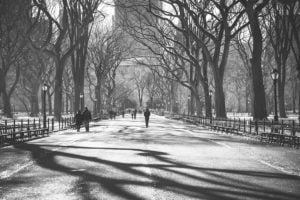What requirements do people need from their private and public spaces to thrive and enjoy life? The COVID-19 lockdown has allowed us to reflect on our achievements and consider future challenges, says Kathlyn Loseby.

Six weeks of living under COVID-19 lockdown have given many of us a sharper appreciation of the virtues and limitations of our private and public spaces.
On one hand, we have seen our local communities blossom. Without cars speeding down the road our community space is suddenly very liveable. Our neighbourhoods are quieter, our streets are safer and the air is cleaner. Social distancing has given pedestrians an opportunity to reclaim the streets. Loose queues snake longer along the pavements and, in the absence of cars, spilling onto the street seems completely natural.
Our open spaces are thriving. Public parks and streets are now lined with people walking in pairs or with their dog, riding bikes and exercising. Bike shops can’t keep up with demand and families are exercising together. Look how low the mileage is on your car! Without all that exhaust we can breathe fresh, clean, HEALTHY air.
And the slower pace means we can have eye to eye contact with the people in our community, and share a nod or a ‘hello’ (try doing that driving in a car).
On the other hand, six weeks restricted to home is far from a holiday for many of us. In Australia we have taken care to ensure that our dwellings are built to keep us sheltered and safe, but can they also keep us sane? Especially when we need to spend far more time inside them, and arrange them as not only a place to live, but also a workplace and school? Watching two opera singers serenade their neighbours with a rendition of “I Still Call Australia Home” from their balconies is delightful and it is these experiences (and recognising our shared humanity) that tie us together.
As architects and urban designers our role is to plan an environment in which people can thrive and enjoy life. This lockdown is an opportunity for us to reflect on what we have achieved, and what are the next challenges we should address.
The success of SEPP 65
One of the recent achievements of our profession has been our input into the development of the NSW legislation, SEPP 65 (State Environmental Planning Policy 65 – Design Quality of Residential Apartment Development), introduced in 2002 and updated in 2015. These guidelines ensure that residential apartments – becoming a prevalent form of residence – are good places to live.
The legislation defines minimum standards for apartment size and ceiling height, open space and balcony, access to natural sunlight and cross ventilation and, lastly, acoustic and visual privacy. These minimum sizes ensure a room can be appropriately furnished, the depth of the room will allow daylight to penetrate and fresh air to circulate, and ceilings are high enough to install a ceiling fan.
A modest balcony allows a step outside for fresh air (or an occasional operatic outburst) without the need to leave the dwelling. Privacy between apartments and minimum separation distances between neighbouring buildings is maintained by cleverly orchestrated sight lines from each apartment. In addition, access to public domain areas, communal facilities and landscaping for a green outlook is guaranteed.
The legislation is widely regarded as having raised the quality of residential apartments in New South Wales. Our profession thought and fought hard to achieve these specific minimum requirements and we will continue to fight hard to resist efforts to water them down.
Future challenges
So, in the light of the COVID-19 lockdown, what should be our next challenges?
I believe we should learn from the spontaneous way our communities have used public spaces as soon as they have been given the chance. To start with: how can we make it easy to get around without a car? This is not just compulsory under lockdown conditions; it is also enjoyable, and good for the local environment, economy and community.
Many cities in the world have enacted policies to do this: Edinburgh, Stockholm, Milan, New York, Bogota, Auckland and San Francisco to name a few.
What specific guidelines can we come up with? We could start with what other cities have shown to work:
- Put a speed limit of 30 km/hr on all local streets.
- Make one central street block in each suburb or country town pedestrian only. No cars.
- Provide bike paths to connect residences to major public transport hubs.
- Provide ample bike storage at each transport hub.
I’d love to hear your thoughts and comments.
Thank you to Dr Michael Zanardo who provided detailed information on SEPP 65. Michael is an architect and urban designer, the director of Studio Zanardo, and a board member of Shelter NSW.
Doctors, public health and transport researchers call on government to enable safe walking and cycling during the COVID-19 pandemic and into the future and have this letter to government.
Kathlyn Loseby is President of the NSW Chapter of the Australian Institute of Architects and Chief Operating Office of Crone Architects. She is presently heading up a group of industry leaders from across key organisations to develop widely informed policy positions and take cooperative action to improve the built environment.
Photo: Maude Bocquillod, Unsplash




















